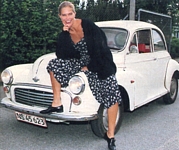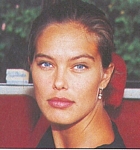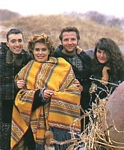U.K. Daily Mail, 5. June 1992
By JESSICA DAVIES and LOUISE ATKINSON
THE GOOD LIFE DANISH WOMEN WON`T GIVE UP - Paternity leave and maternity pay plus top jobs for the girls. Why these women voted ´NO´ to Europe
- "Our quality of life is simply better than anywhere else"
As women across Europe battle on, juggling husbands, babies and
careers, many will look enviously at the life Danish women have carved
out for themselves. And many will understand why their Danish sisters -
anxious that Denmark´s unequalled welfare system should not be
eroded by EC standardisation - roundly rejected the Maastricht Treaty
in this week´s referendum.
No country in the world offers a better deal for women than Denmark,
and in a Amercian quality of life survey published last week, Denmark
came top out of 140 countries. Nowhere else gives as much maternity and
paternity leave, spends as much on creche facilities, provides a more
elaborate network of state childcare, or has more women in senior
positions.
Of course, this has to be paid for. The average rate of tax is 52 per
cent, but Danish women think the money is being well spent.
Renee Simonsen, the former Vogue covergirl dubbed ´the face of
the Eighties´ at the height of her modelling career, was one of
57 per cent of Danish women who ticked the ´no´ box. She
lived in New York for six years, four of them as the girlfriend of
Duran Duran pop star John Taylor (now husband to Amanda de Cadenet).
Three years ago she moved back to Denmark to resume her interrupted
education: now, aged 27, she has a place at Copenhagen University to
study psychology, starting in September. She knows the opportunity
might not have been so readily available elsewhere.
"I was so concerned that Denmark would just be swallowed up", she says,
explaining her decision to turn her back on Europe. "I´m still in
favour of the EC, but I don´t want a joint army and a joint
currency.
Our welfare system is so well developed here, everything is taken care
of. The minute a child is born, its name is put on a list and when a
vacancy comes up the child can go into a nursery - as young as six
months if the mother wants.
The most scary part is that Amercia appears to be the role model for
what the EC might become. Yet so many Americans seem to fall through
the net, so many don´t get education or welfare. Having lived
there, I know the quality of life simply isn´t as good as ours."
The level of anxiety about the looming threat of Europe has been so
high that an anti-EC grass roots movement, Denmark 92, was formed last
December. Professor Liese Lyck, an economist and spokeswoman for the
movement, emphasises that hostility to Europe is not ignorant and
isolationist. She says Danish women, well-educated and fully appraised
of the facts, have a real understanding of what Maastricht could mean.
There´s a trend in Europe in cutting down on the public sector.
We´ve had a little of this, but not nearly as much as other
countries, and we don´t want it to go any further. We have a lot
of excellent free services, we want to keep them."
"Danish women", she adds, "are also fearful for their jobs. We have the
highest employed labour force in Europe; 29 per cent of Danish women
work. Before we joined the EC unemployment was at 1 per cent; now
it´s 10 per cent. We look around and see unemployment is higher
in EC countries than in countries that have stayed out - other Nordic
countries, for example."
In prosperous Copenhagen you will meet scores of articulate women
prepared to talk about their worries. Heidi Pederson, a 20-year-old
office trainee, is especially concerned about the military implications
of the European family.
"I could never say ´yes´ to a treaty that could mean my
children, or their children, die fighting a European war. I realise
this in an emotional issue, but I believe it´s one that many
Danish women see as very important."
Christine Cordsen, a 34-year-old magazine editor who is divorced and
the mother of a five-year-old son also voted ´no´. It is
possible to be a single parent and have a career in Denmark", she says.
"And I don´t think the same could be said for many other EC
countries."
Vivienne McKee, an English actress who is married to a Dane and has
lived in Denmark for 11 years, has no doubts about how she would have
voted had she been a Danish citizen. "I would definetely have said
´no´. I would not like to see the Danish social system
change. I could never have achieved in England what I have in Denmark.
I write, direct and act in my own productions.
Denmark is streets ahead of England when it comes to equality of the
sexes - both at work and in the home. Danish men wouldn´t dare to
treat women differently."

















